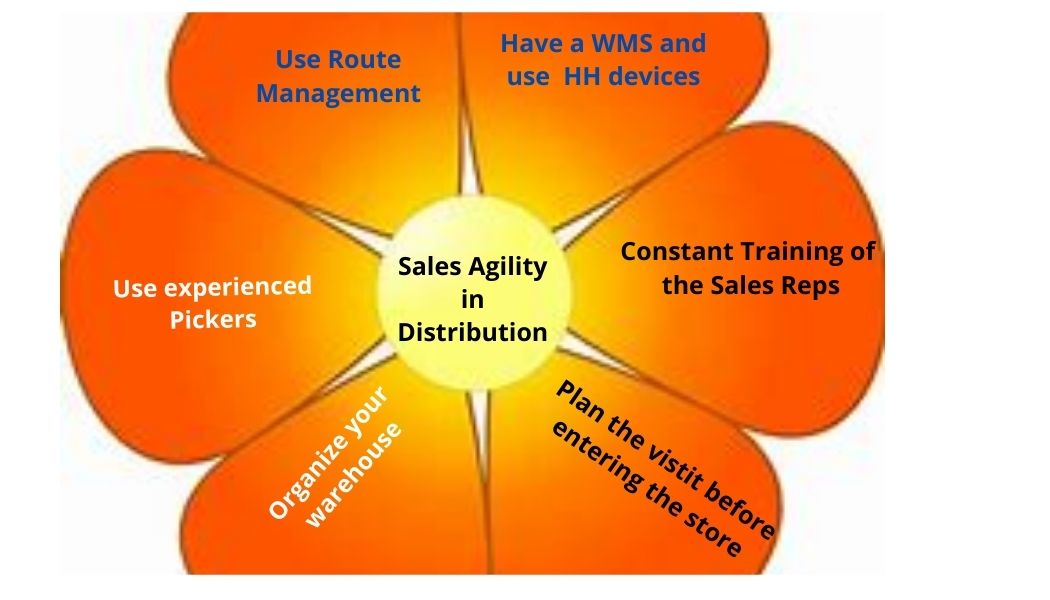
How to improve sales agility in a distribution operation
Sales agility refers to the ability of a company to fulfill a sale efficiently and in the shortest amount of time. If you are a distributor it involves the optimization of the order-taking process, the pick and pack of the order, and the delivery. In this article, I give some suggestions on how to improve these processes in order to optimize your sales agility.
Sales agility in the order taking process
In a distribution operation, the order is commonly taken by the sales rep in the store. For this process to be efficient, agile and to customer satisfaction, we recommend the following strategies.
- Train your sales reps in modern and agile sales techniques. Most companies provide basic training to new hires, but very few update course content and reinforce training. According to different sources, between 70% and 80% of sales reps forget the basics of the training within one year, and organizations that use post-training reinforcement, experience a 34% increase in sales.
- Plan your sales approach. A distributor sales rep has a portfolio of 50 to 75 stores to serve. Considering that each store is different, the only way to make an agile sale is by planning the strategy before entering the store. These are some of the issues to be done:
- Review the available offers and plan the sale according to them.
- If you have the information, see what was sold last time.
- Review in your personal notes what was left in the storage on the last visit.
- Use a handheld application. Having a portable device to take and place the order minimizes errors and the time it takes to transmit the order to the warehouse for picking. Without this, the orders will reach the company when the sales rep goes to the office, and the sales administration people have to enter the order into the system, which means at least a two-day delay in fulfilling the order.
Sales agility in the picking process
The order picking process involves fetching the items on the order and placing them in a box or pallet for loading onto the truck. These are some ways of improving sales agility in the picking.
- Warehouse organization. Of all warehouse processes, picking takes up more than 50% of a warehouse’s labor and time. So, it is logical to think about knowing exactly where the products are located in the warehouse. In “16 tips to boost your warehouse productivity” we went over different warehouse setups that will reduce your overall warehouse turnaround time.
- Use experienced pickers. Picking is one of the most critical areas in a warehouse operation. Errors resulting from wrong or incomplete picking result in extended fulfillment time, delivery costs, and customer satisfaction. Picking errors will minimize if the picker has worked in the warehouse for some time and has developed an understanding of the products and warehouse layout.
- Have a warehouse management system in place. A WMS adapted to your operation ensures sales agility in picking. Features you should look for when selecting your WMS:
- Allow handheld devices for picking.
- Provide locations where the items are stored.
- Suggest the picking beam.
- Suggest the optimal picking route

Sales agility in the delivery
The delivery process involves truck loading and delivery. Below are some considerations you should keep in mind when thinking about the sales agility associated with the delivery.
- Warehouse organization. Having the warehouse organized by areas helps the loading process since the picked orders will be in specific places associated with the truck.
- Have Route Management software. Good route management software will suggest the best delivery route, thus minimizing delivery time and gas consumed.
- Have a suitable fleet. The ideal number of trucks is equal to the average number of daily orders to be delivered divided by the average number of daily stops a truck can make. If you have fewer trucks than this index shows, then you will end up with an order not delivered in the truck. If that is the case you can juggle your own fleet and outsource some of the deliveries to delivery companies or independent contractors.
I hope this article has been helpful to you. I will continue to post information related to warehouse management, distribution practices and trends, and the economy in general. If you are interested in this article or want to learn more about Laceup Solutions, please subscribe to stay updated on future articles.
There is a lot of relevant information on our channel. Check out this video on a related subject.


Sorry, the comment form is closed at this time.